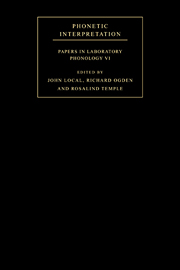Book contents
- Frontmatter
- Contents
- List of contributors
- Acknowledgements
- Introduction
- Part I Phonological representations and the lexicon
- Part II Phonetic interpretation and phrasal structure
- Part III Phonetic interpretation and syllable structure
- Part IV Phonology and natural speech production: tasks, contrasts and explanations
- References
- Index of names
- Index of subjects
Introduction
Published online by Cambridge University Press: 22 September 2009
- Frontmatter
- Contents
- List of contributors
- Acknowledgements
- Introduction
- Part I Phonological representations and the lexicon
- Part II Phonetic interpretation and phrasal structure
- Part III Phonetic interpretation and syllable structure
- Part IV Phonology and natural speech production: tasks, contrasts and explanations
- References
- Index of names
- Index of subjects
Summary
There is a long tradition in Europe and North America of employing laboratory techniques to explore questions within phonetics (Hardcastle and Laver 1997; Ohala, Bronstein, Busà, Lewis and Weigel 1999). However, the coherent use of laboratory techniques to address phonological questions has a somewhat shorter history. Indeed the term ‘Laboratory Phonology’ (LP), which features in the title of this book, was coined by Janet Pierrehumbert only some ten years ago to characterise a growing body of experimental research on sound structure, its representation and its physical exponents (Kingston and Beckman 1990; Pierrehumbert, Beckman and Ladd 1996). Up to that point it had been typical for workers in other areas such as psychology to borrow the ideas from phonology and apply them within experimental settings to address the concerns of their own disciplines rather than to illuminate linguistic theory per se.
Nonetheless, over forty years ago the linguist, phonetician and phonologist J. R. Firth wrote of taking ‘linguistics into the laboratory’ (1957: 25). The point of doing this, Firth was at pains to emphasise, was not to engage in an ‘experimental phonetics’ (‘a very different scientific procedure’) but rather to support the exploration of the relationships between phonetics, phonology and the ‘grammar’ of language. Revisiting this matter in 1959, he writes: ‘The linguist will, of necessity, have in mind tentative analysis at the phonological and grammatical levels, and unless the results of laboratory experiments throw light on findings at these levels there is no profit in them’ (Firth 1959: 34–5).
Information
- Type
- Chapter
- Information
- Phonetic InterpretationPapers in Laboratory Phonology VI, pp. 1 - 10Publisher: Cambridge University PressPrint publication year: 2004
